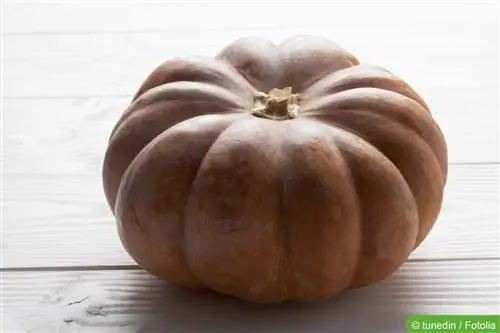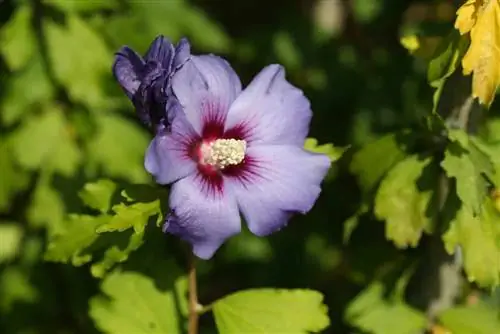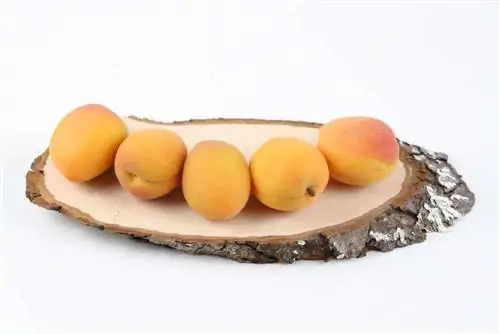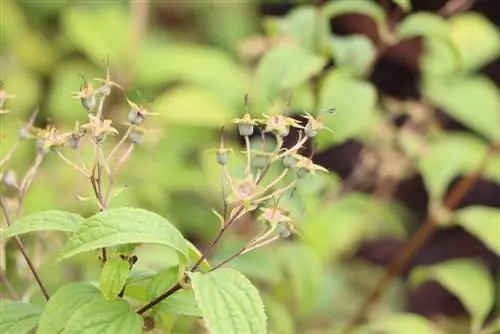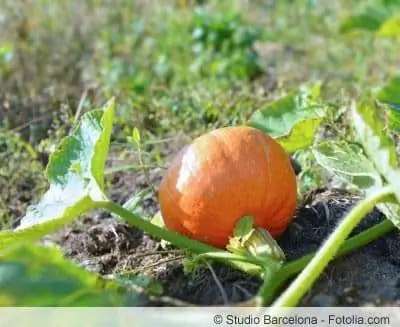- Author admin [email protected].
- Public 2023-12-17 03:39.
- Last modified 2025-01-24 12:45.
Pumpkins have been grown in our gardens for several hundred years. Over time, new, tasty varieties were added. One of these is the nutmeg pumpkin, which ensures fresh dishes all winter long with its firm flesh, good shelf life and pleasant taste. It is easy to grow and requires little care, but is worth the little effort with a bountiful harvest. Here we give you some advice on how you can easily cultivate the nutmeg pumpkin in your own garden.
Location and soil
Pumpkins thrive in almost any soil, but it is best to plant them in loose, well-drained soil. A sunny to partially shaded spot proves to be ideal. Nutrient-rich soil is an advantage, but not a requirement. Then you can help with compost. The nutmeg pumpkin does not need any special fertilizer. Heat is also an important criterion for cultivating nutmeg pumpkins. If the daytime temperature is cooler than 12°, a tunnel film is recommended for the young plants so as not to hinder growth. It can be removed as soon as the daytime temperature consistently exceeds 15°, but at the latest when the first flowers appear to allow insects access.
Pumpkins in general need a lot of water, the nutmeg pumpkin is no exception. So make sure that the soil doesn't dry out. However, waterlogging is not pleasant either, so ensure that the soil structure is loose. As soon as the plants have grown, around mid to late June, they can be mulched. This means less watering is required and the mulch also helps to keep the growing fruits dry later. This prevents rot from setting in in rainy summers, especially with heavy and large fruits.
Tip:
When sowing, make sure that the plant has enough space later. On average, you can expect a good one square meter per pumpkin plant, a little more, but it shouldn't be less.
Sowing and care
Ideally, the nutmeg pumpkin is sown in the garden at the end of April to the beginning. You can also prefer young plants in the nursery pot, then the seedlings are pricked out. Plants sown outside should be transplanted about three weeks after germination. When sowing, up to three seeds are placed in one hole; only the strongest plant remains after germination. This means the plants don't take up space, water and nutrients from each other. Once the plant has grown and spread, it is worth pruning the main stem. No more than two to three fruits should ripen per plant so that there are magnificent, large and good quality fruits. At the beginning, remove weeds that appear regularly so that no nutrients or water are lost.
- keep enough distance between the planting holes, it should be 50 to 80 cm
- water generously after sowing, avoid waterlogging so that the seeds do not rot
- When watering, make sure that neither leaves nor fruit get wet, water directly on the ground
- A wooden board can be placed underneath to protect large fruits from rot or pest infestation
- water every day, nutmeg pumpkins need a lot of water
- water in the evening so that the plant can absorb the water overnight, so it doesn't evaporate in the sun
Diseases and pests

Not only we humans like the nutmeg pumpkin, the snails also love the aromatic plants in the garden. To prevent this, you should regularly check the plants for snail infestation. If the pests appear, they should be collected immediately. For larger populations, you can build a snail fence to keep the animals away permanently. The use of chemical agents should generally be avoided in order to prevent the ingredients from getting into the pumpkins. Another problem can be aphids that attack the leaves and stems. However, since the nutmeg pumpkin is a strong plant, such an infestation shouldn't bother it much. If the plants are still young, a strong spray with a sharp jet of water is sufficient. As soon as fruit is already present, this should not be done to prevent rot. Diseases that can occur include powdery mildew and leaf brown, both of which are fungal diseases that should only be controlled with fungicides if there is a severe infestation. To avoid these diseases, you can prevent them by leaving enough space and watering from below. Shortened, strong plants can defend themselves well against pests and diseases.
- apply a tea made from two cloves of garlic and half a liter of water with the spray bottle to combat mildew
- Milk is also effective against mildew, the microorganisms fight the fungus, 1 part water and 8 parts milk, do not use in direct sunlight
Tip:
The fungal diseases usually only appear in late summer, so they have no effect on the fruits themselves. Treatment with home remedies does not harm the fruit and can be repeated weekly if necessary.
Harvesting and storage
Nutmeg pumpkins are harvested in the fall, five to six months after sowing. They are usually ripe in mid to late September, but you should only pick them when the leaves and stems are dry. When harvesting, the fruits should be handled with particular care if they are intended for long-term storage. Any collision may cause damage to the shell, which could result in rot or mold.
- only store whole pumpkins in a dry place, the temperature should be between 12°C and 18°C
- Check stored nutmeg pumpkins for integrity at least every 14 days
- If the stem is no longer firm and woody, the pumpkin could rot from the inside
- When storing, the fruits should not touch each other
- never lay directly on the floor, a small pallet also ensures air supply from below
Conclusion
The delicious nutmeg pumpkins from our own garden make for tasty soups, casseroles, cakes and much more all winter long. The aromatic fruits can be cultivated in your own garden without much effort and last for months, so you can take your time with processing. The easy cultivation and uncomplicated care make the nutmeg pumpkin a must for everyone who appreciates the good taste of the he althy fruits.
What you should know about nutmeg pumpkin soon
- The nutmeg pumpkin has a slight flavor of nutmeg. This also gives it its name.
- The nutmeg pumpkin is one of the most popular pumpkin varieties on the German market, along with the garden pumpkin and the Hokkaido pumpkin.
- With a weight of up to 40 kilograms per piece, the nutmeg pumpkin is also one of the largest pumpkin varieties.
- The color of its shell varies between dark green, orange and brown.
Cultivation
- The sowing site should have plenty of sunlight, warm and protected from wind.
- In addition, sowing should be carried out on a compost heap, as the humus there is sufficiently moist and provides the necessary nutrients.
- You should buy the seeds for cultivation in hardware stores or garden centers or in special online shops.
- The pumpkin seeds from already harvested nutmeg pumpkins are not suitable for the successful cultivation of nutmeg pumpkins due to their nature.
- For breeding, you can also pollinate the female flowers yourself with a brush.
- The seeds are initially sown in a container in April.
- From May you can plant the small plants at a distance of around one and a half meters from each other.
- The planting of the nutmeg pumpkin plants should definitely only happen after the Ice Saints!
- Regular watering and supplying the nutmeg pumpkin plant with nutrients are sufficient to care for the seeds.
Planting out
- It is important when sowing young pumpkin plants that the roots and shoots are not damaged.
- The shoots should be shortened if they have reached a length of 60 cm or more or if the fourth leaf base has already formed.
- When the pumpkin fruit of the nutmeg squash develops, the pumpkin plant has an increased water requirement.
- If you want to grow a large pumpkin fruit, you should make sure that the tendril on which the fruit forms is in the shade.
- In addition, you should only let one flower grow on each shoot and cut the rest.
- Smaller nutmeg pumpkins can be grown by always trimming the main shoot when the fifth or sixth leaf has grown out.
- Basically, after around eight fruit sets, you should separate all other female flowers from the plant.
- If there is strong sunlight, you can cover the nutmeg pumpkin fruits with damp cloths. This prevents cracks in the shell.
Harvest
- To check whether the nutmeg pumpkins are ripe, simply tap the peel of the respective fruit. If the sound sounds hollow, the pumpkin is ripe.
- The nutmeg pumpkin is harvested at the beginning of November at the latest. You should make sure that the nutmeg pumpkins do not get frost.
- After harvesting, the nutmeg pumpkin is initially stored in a warm place, for example in a boiler room, for five to seven days.
- If the shell remains undamaged, store the nutmeg pumpkins at 10 to 13 °C in a cool, dry place on a wooden pallet.
- The nutmeg pumpkin can be stored at this point for four to six months under constant temperature conditions.

